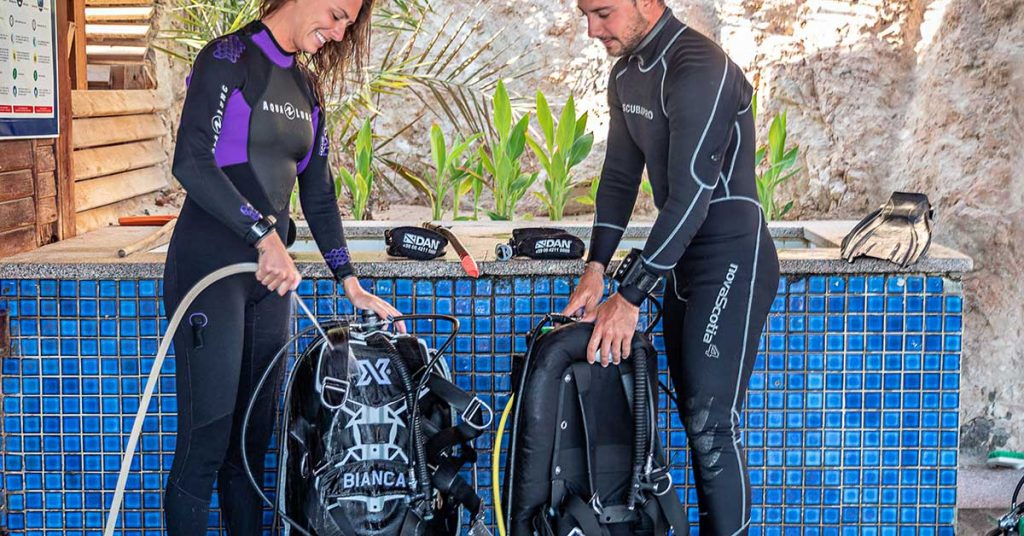Traveling with your own dive gear or rental equipment you are familiar with is best. As a minimum, carry-on your dive computer and prescription lens mask. If possible, keep your regulator and underwater camera in your carry-on luggage.
At your destination
Give your equipment the best post-dive rinse or soak you can, but then allow it to remain wet throughout your stay. Communal rinse buckets and brackish water hoses will not allow you to get all the salt out. Keeping your gear wet will help prevent salt crystals from forming. This can cause trouble.
To help keep your wetsuit pleasant smelling, use REEK Away and don’t eat asparagus.
When you get home
Don’t just put your equipment away and not worry about it until your next trip. This is your opportunity to give your gear the kind of thorough rinsing you generally can’t do at your destination.
Regulators, dive computers, cameras and housings
To start, have regulator dust caps in place and camera/housing O-rings installed. You do not want water getting inside.
- Fill a deep tub or sink with water as hot as your hands can stand.
- Add a cup or more of white vinegar.
- Let everything soak a few minutes.
- Swish each item around to remove any dried salt deposits.
- Push every button and twist all the knobs on the computer and camera many times.
Next:
- Drain the water.
- Refill tub with fresh, cool water (no vinegar).
- Repeat the process of soaking, swishing, pushing buttons and turning knobs. Let the water out and set items aside to dry.
Be careful not to scratch your camera or housing lens or dome port: Wipe it dry with a lint-free cloth.
BCs and wetsuits
BCs and wetsuits are prone to microbes and stench. Regular detergents are not recommended for use on items containing neoprene or rubber. Use only commercially available BC and wetsuit shampoos that are:
- Environmentally friendly.
- Hypo-allergenic.
- Non-toxic.
- Biodegradable.
Here is how you use them:
- Start by filling a deep tub or sink with fresh, cool water.
- Add the recommended amount of BC or wetsuit cleaner or shampoo.
- Aggressively swish everything around to distribute the disinfecting, bacteria-killing, odor-eliminating solution.
- Let water out.
- Fill a tub or sink again with fresh water and repeat.
Now it is time to dry.
- Do not put wetsuits in the dryer (duh!). Hang them up to dry, out of direct sunlight. Wetsuits are best hung on wetsuit hangers or hangers with a very wide base. Once the outside of the wetsuit is dry, turn it inside-out and let dry again.
After your BC is properly rinsed on the outside, its time to address the inside. It must be cleaned, disinfected and dried as well.
- Mix a batch of diluted BC cleaner. Open the BC’s oral inflator and pour the solution inside. Fill the BC the rest of the way with fresh, cool water. Let it soak.
- Now turn the BC around and around so you get the water everywhere. Let some water out through each of the dumps including tops shoulders, the lower dump valves and the alternate-air-source or power inflator.
- Finally, let all water out of the BC. Fill it full with air and let it sit awhile. Let all puddled water out through whichever drain you prefer. Fill it with air again and set it somewhere, our of direct sunlight, to dry thoroughly.
Between-trip storage
When the post-trip cleaning and drying process in finished, store your equipment in an air-conditioned room, our of direct sunlight. In other words:
- No hot vehicle trunks.
- No hot laundry rooms.
- No hot attics.
- No hot garages.
Don’t forget annual service
Your life-support equipment requires annual inspection and service. This includes both regulators and BCs. Both have many moving parts that need cleaning in an ultrasonic bath, replacement of worn parts and thorough lubrication.
You also want to make sure your dive computer has plenty of battery life left. If it dies in the middle of your next trip, there will not be much you can do about it.

